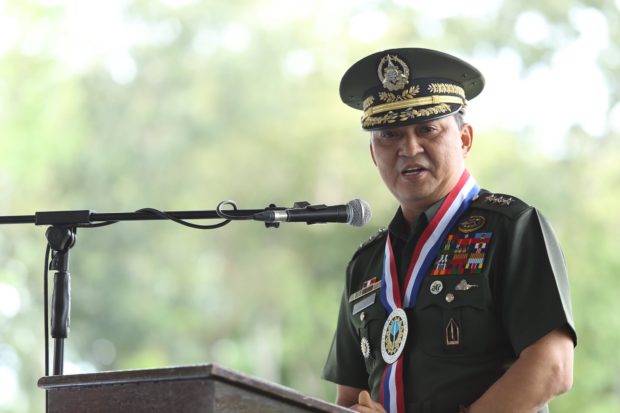AFP chief seeks an end to local armed conflict before shift to territorial defense

Armed Forces of the Philippines chief Lt. Gen. Felimon Santos Jr. / Photo from AFP PAO
MANILA, Philippines — Armed Forces of the Philippines (AFP) chief Lt. Gen. Felimon Santos Jr. said he would prioritize on ending local armed conflict during his term before they can finally shift their full focus on a territorial defense role.
“Lagi nating sinasabi natin tapusin ang local terrorist armed conflict. Business and economy will boom, lahat nagkakaisa para sa sa bansa natin. Then we could focus on the real threat against sa territory,” Santos said in an interview with CNN Philippines on Tuesday night.
(We’ve always said that we need to end the local terrorist armed conflict. Business and economy will boom, all of us will be united for our country. Then we could focus on the real threat against our territory.)
Communist insurgency and the neutralization of terrorists in Mindanao continue to be a hindrance to the military’s total shift to external defense.
“My priority as AFP chief is ending local armed conflict. Pag natapos natin ‘yan, mawawala yung mga groups na nag-e-establish ng hatred sa government. Hopefully, we will be one as Filipinos. If we have done that, ‘yong territorial defense madali na lang ’yon,” said Santos, who will serve as AFP chief of staff until his retirement in early August.
(My priority is ending local armed conflict. If we finally end it, the groups that establish hate against the government will go away. Hopefully, we will be one as Filipinos. If we have done that, the territorial defense role would be easy.)
Even with the current focus on internal security challenges, the military has started to develop its capabilities for territorial defense through the AFP modernization program.
Santos said they are aiming “to be a credible armed forces” before the decade ends. The modernization program is divided into three phases called “horizon,” and the last phase is from 2023 to 2028.
“Hopefully, we’ll attain that objective,” he said.
The AFP chief said some of the military equipment expected to be delivered this year include two frigates for the Philippine Navy, which are currently being built in South Korea.
The first batch of the Black Hawk helicopters are also expected this year. Santos said the first five out of the 16 will be delivered this 2020.
He also mentioned their plans of command, control, communications, computers, intelligence, surveillance, target acquisition and reconnaissance (C4ISTAR) capability.
“It’s for command and control. We’ll control the interoperability of all what we have. The airplane can communicate with the ground troops. Magkakaroon ng common communication…parang pinaka-control center.)
(It’s for command and control. We’ll control the interoperability of all what we have. The airplane can communicate with ground toops. We’ll have common communication, like our main control center.)
“We’re trying to catch up,” he said.
The need to shift to territorial defense is highlighted by China’s continued aggression in the West Philippine Sea. But Santos would not say what they are specifically preparing for in terms of territorial defense.
“It’s for a potential threat. ‘Di natin masabi ang alignment of the superpowers. Basta what we’ll have is not for offensive but to protect our country,” he said.
(It’s for a potential threat. We can’t predict the alignment of the superpowers. Our (modernization) goal is not for offensive but to protect our country.)